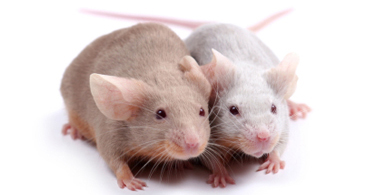Sexy Sniffing
BU researchers find new brain pathway for pheromones in mice

The profits of the perfume and cologne industries are based on the notion that fragrance can boost your sex appeal. Some companies even claim to have bottled human pheromones, chemicals that could lead to a subconscious link between scent and sexual arousal. But unlike the smell of Axe body spray, the scientific evidence of that connection is not yet overwhelming.
Now, a discovery by two Boston University scientists could bolster the idea that when it comes to choosing mates, the nose knows more than we think. James Cherry, a College of Arts and Sciences associate professor of psychology, and Michael Baum, a CAS professor of biology, have found a new pathway for odor to activate the reproductive centers in the brains in mice. If the same pathway is active in humans, it could mean that the sense of smell has a role in sexual attraction.
The basic fact that odor plays a role in mouse sexual behavior is no surprise to the two researchers. For a decade, the two have studied olfaction and the other sensory inputs of mouse brains.
“If you work with rodents, then you learn very quickly that olfaction is probably the most important sense for them,” says Cherry. “It clearly plays a very important role in a lot of what they do, which in addition to eating is mating.”
But the devil is in the details, because mice brains, like the brains of many animals, have more than one way to process a sniff. For years, scientists differentiated the main olfactory system, thought to process only volatile odors in the air, from the “accessory olfactory pathway,” which they believed picks up on the odors from direct physical contact and gives chemical cues about an animal’s gender and reproductive readiness. In other words, researchers believed it was the accessory olfactory system that detected pheromones.
That’s where it gets tricky for humans. We have far fewer odorant receptors than rodents have, and scientists don’t believe humans have a functioning accessory olfactory system, meaning our brains would be impervious to the chemical signals of pheromones.
Not so fast, say Cherry and Baum. Over two years, working with Ningdong "Cam" Kang (GRS’09), a biology doctoral student, the researchers exposed mice to mouse urine, the main odorant of mouse-to-mouse communication. Cherry, Baum, and Kang then traced the pathway of tell-tale chemicals through the mouse brains, from the olfactory systems to the amygdala, part of the brain’s reproductive core. They found that mice brains process pheromones not only through the accessory olfactory system, but through the main olfactory system as well.
“We found direct connections from the main olfactory system to these reproductive centers in the brain,” Cherry explains. What that could mean for humans, says Baum, is that our brains may be able to process pheromones after all.
The prevailing theory “is that as primates evolved and developed better vision, their sense of smell degraded,” says Baum. “But our argument would be that just because that system has deteriorated in apes and people, it doesn’t mean that olfactory cues are irrelevant.”
Their findings could reinforce other evidence of human receptivity to pheromones that has accumulated over recent decades, beginning with a series of studies in the 1970s and the 1980s that showed that underarm odor triggered “menstrual synchrony” in female roommates. In 2005, Swedish researchers used functional magnetic resonance imaging to show that women and homosexual men had more brain activity than heterosexual men when exposed to the odor of a testosterone derivative commonly found in male sweat, whereas the brains of men and homosexual women reacted more to the scent of a steroid common in female urine.
Of course, showing brain activation is one thing, but demonstrating a causal link to behavior is another. Now that Cherry and Baum have demonstrated the connections between the main olfactory system and the reproductive center of the mouse brain, the next step, says Cherry, is “to demonstrate that, functionally, it’s driving some of these important reproductive behaviors and to look into the extent to which this system is involved in these behaviors in comparison to the accessory system.”
According to Cherry, the research he and Baum are performing is not of interest just to the perfume industry. It’s an investigation into a model of the mind, how a brain takes in sensory information, creates perceptions, and ultimately informs behaviors. Still, he understands the implications of supporting the case for human pheromones.
For humans, “the olfactory system is the third-fiddle sense or even fourth-fiddle. People think you could live without it, that it’s sort of a quality-of-life sense,” he says. “But to think that our mate choice, one of the most critical decisions we make in life, could be affected by how some other individual smells — that’s intriguing.”
Chris Berdik can be reached at cberdik@bu.edu.